First shot: The COVID vaccine’s long trip from loading dock to first injection
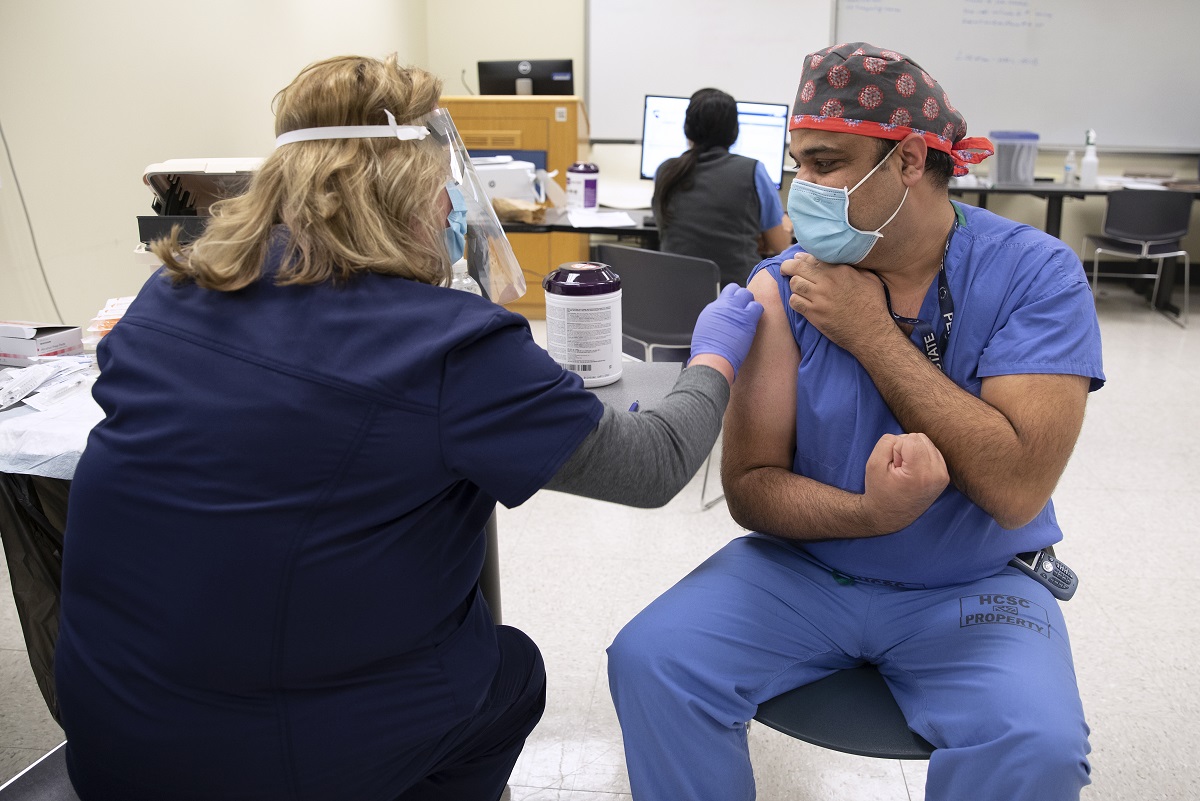
It arrives without fanfare. Eight hours later, a nurse injects it into the arm of a health care worker, who raises his fist in triumph.
It’s the moment for which many have been hoping and praying for nearly a year. All the hand-washing, masks, personal protective equipment (PPE), challenges both logistical and personal, fears, suffering and sorrow have led to this. A vaccine. Hope at last.
On Dec. 21, 2020, the day the first shipment of the Pfizer-BioNTech vaccine against COVID-19 arrives, Penn State Health’s acute care hospitals have treated and discharged 1,389 people who contracted the illness since the pandemic began. One-hundred-thirty-nine Penn State Health patients have died from the disease. At Penn State Health Milton S. Hershey Medical Center, people are holding their breath for what could be the beginning of the end of the pandemic.
“We were tracking it like a kid tracking their package at Christmas,” Deborah Berini, the Milton S. Hershey Medical Center president, tells Dr. Donovan McQuaite, the first employee to receive the vaccine.
Four days earlier, Penn State Health St. Joseph Medical Center received its first 975 doses. The day after Hershey Medical Center received its first doses, Penn State Health Holy Spirit Medical Center received its first box full of vials. Since then, the hospitals have immunized more than 10,000 of their employees, starting with those most exposed to the virus.
At Hershey, in the hours between the vaccine’s arrival and McQuaite’s arm, inventory personnel and pharmacy technicians run a gauntlet they’ve never run before, fine-tuning process against time and temperature to ensure the vaccine can start saving lives.
It begins with a cardboard box.
7:49 a.m. Shipment arrives
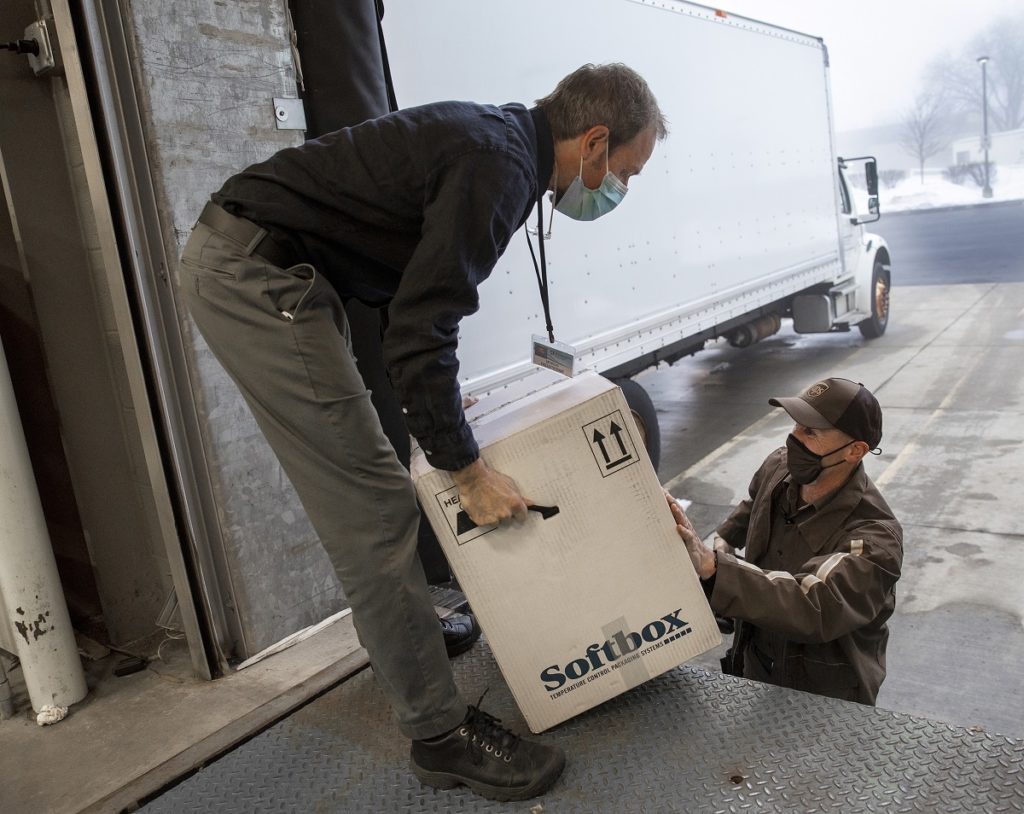
Nick Loftus, supervisor for Shipping and Receiving at Hershey Medical Center, receives the delivery of COVID-19 vaccinations at dock B.
Four days before Christmas, a UPS man walks through a cold morning to a Hershey Medical Center supply building hugging the box.
It’s easy to miss the significance. The man wears a jacket and a brown UPS ball cap, not a hazmat suit. He steps up to the loading dock and passes the white cardboard cube to Nick Loftus, who stoops to take it.
The shipping and receiving supervisor has only worked at Hershey Medical Center for three months. “A lot of times, we’re getting stuff like mops,” he says. “This is definitely the biggest thing that’s hit the dock since I’ve been here.”
It weighs 60.7 pounds. It shipped through the night from Kalamazoo, Mich., by UPS Next Day delivery. The label says it contains dry ice. It might be a mail-order steak dinner or popsicles. Instead, inside is the vaccine.
Elsewhere in the Strategic Services Building on the west end of campus, an army of facilities personnel have converted rooms to keep pace with the virus. Shelves rise to the warehouse ceilings loaded with PPE and other supplies geared to halt the pandemic that has sickened millions worldwide and killed more than 350,000 in the U.S.
“Typically, this building has held some needles, some syringes and the Ebola stuff,” says Justin Kemp, manager of supply and logistics, looking up at his shelves. “Since COVID, it’s been going full throttle.”
7:50 a.m. Delivery

Brad Delessio, a receiving clerk at Hershey Medical Center, transports the package of COVID-19 vaccinations to the pharmacy.
Loftus sets the box on a cart, and Bradley Delessio pushes it away, speed walking.
“We always say boxes are boxes,” he says, “but this is one everybody’s been waiting for.”
He wheels it aboard a service elevator that takes him down one level. The doors open into a tunnel. Delessio marches its length at his fast clip, several hundred yards under parking lots and landscaping beneath Penn State College of Medicine. It takes several minutes to reach an entry marked Pharmacy where he elbows a button that opens the door.
“Morning, Stef,” he says. “Got a hot package.”
“Yay!” someone says.
The room is filled with lab equipment and the soft hum of machines. Delissio unloads his cargo onto a shelf. A handful of people in masks gather.
“We might need an armed guard outside,” someone says. There are a few nervous laughs.
8 a.m. Into the freezer
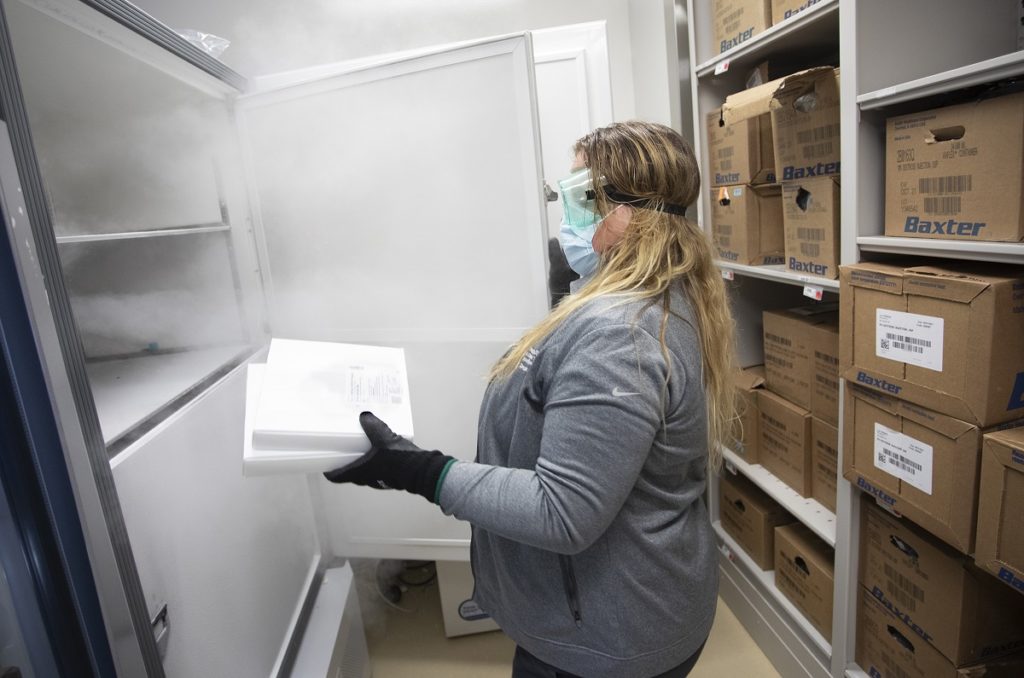
Raven Dailey, a pharmacy inventory coordinator at Hershey Medical Center, stores the first package of COVID-19 vaccinations in the freezer at the pharmacy.
Pharmacy Buyer Raven Dailey cuts open the cardboard flaps. Under several pieces of packing foam rests a silver bag in a nest of 32 pounds of dry ice.
From the thermal bag, they pull two flat, cardboard boxes, each the size of a small, microwave pizza.
The Pfizer-BioNTech vaccine – the first developed in the U.S. – must be kept between -60 and -80 degrees Celsius.
The shipment splits 390 vials between the two boxes. Each purple-capped vial contains five doses, for a total of 1,950. The pharmacists could stretch it to six doses per vial according to information from the Centers for Disease Control and Prevention and the U.S. Food and Drug Administration.
They have to put it into the freezer within five minutes, or it’s all ruined.
The freezer is not a Maytag. It’s a mammoth, gray machine with a large digital gauge on the front that reads -75 degrees at the moment. Penn State Health purchased the device specifically for the vaccine. It had a smaller freezer capable of dipping to those depths of temperature, but that freezer is used to store experimental drugs. Federal regulations won’t allow both to take up the same space.
Several layers of redundancy protect it from a power outage. It’s on an emergency outlet, which means Hershey Medical Center’s generators will keep it running in a blackout. It has two compressors. If one fails, the other switches on to take its place. There’s also a carbon dioxide tank if the other three precautions fail.
Dailey carries the boxes to the freezer and puts them in.
11:20 a.m. From freezer to fridge
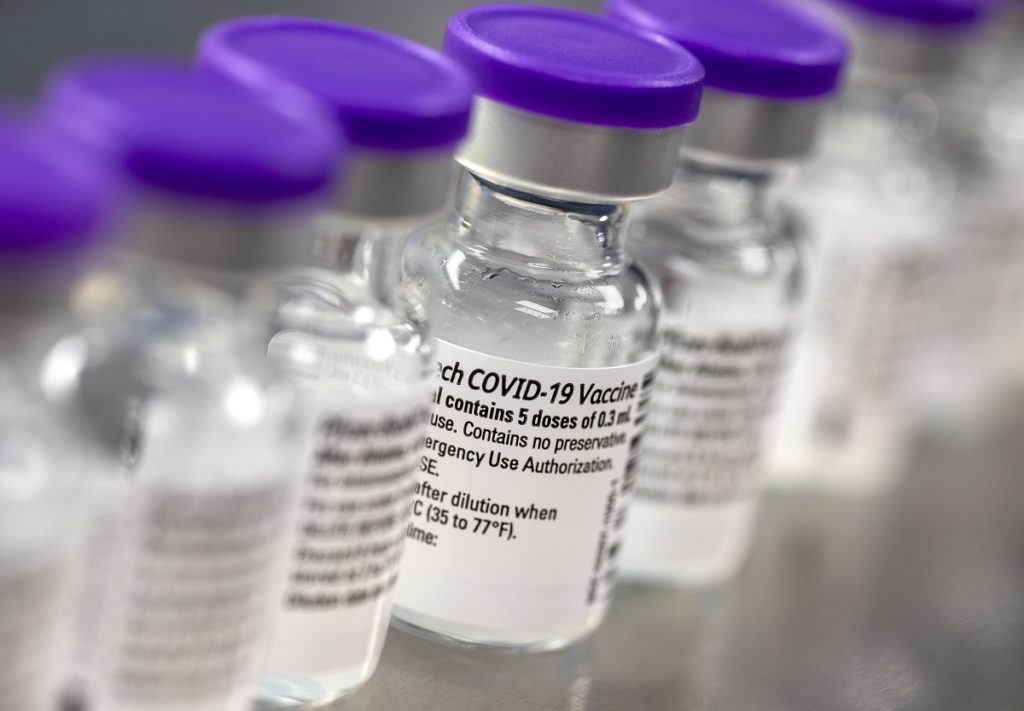
Vials of the vaccine are thawed in a refrigerator before they are diluted and prepared for injection.
Melissa Messick’s job often looks like a photo negative of the efforts others go through to prevent the spread of COVID. She and her colleagues don PPE, but instead of protecting humans from dangerous microscopic organisms, Messick protects microscopic organisms from humans. Today, her job is to makes sure the COVID vaccine isn’t contaminated.
She and her team at the Hershey Medical Center Pharmacy have used the sterile environment to help produce antidotes and drugs for everything from fire ant venom for a health care worker in South Carolina to snakebite cures. During COVID-19, the lab has been busy producing drugs like Remdesivir to treat the pandemic.
But they’ve never done work like this before, she says. Messick, who is manager of inpatient pharmacy sterile products services, goes to the COVID-19 vaccine freezer with a small, white tray with a plan to thaw the first doses of the vaccine.
She has three minutes to take the pizza box from the freezer, remove the vials she wants, put them in the tray and return the box to the freezer. If she takes longer, the doses she wants to return to the freezer can’t be refrozen.
“I know it doesn’t take that long,” she tells her team later with a laugh, “but it’s a lot of pressure.”
Messick opts to open the door to the freezer, open the box while it’s still inside and load her tray. When she closes the door, the digital readout shows the temperature has risen.
She and Vince Lacroce, senior director of pharmacy, decide that wasn’t the best way to do it. Better to remove the box and do the work outside the freezer.
“I think it’s important we document everything,” Lacroce says.
It’s one of many seemingly small but high-stakes lessons the team will learn throughout the day. They’ve been preparing for the logistics of this day for weeks, but there are always incidentals you only learn by doing.
“We don’t usually work with frozen things,” Messick explains.
The vaccine takes 30 minutes to thaw outside the freezer, and once it’s thawed it must be reconstituted and injected within six hours.
Messick places the first 16 vials of COVID-19 vaccine that will inoculate Penn State Health employees into the refrigerator to slow the thawing. Inside the refrigerator, the vaccine is good for five days.
2:40 p.m. Dilution
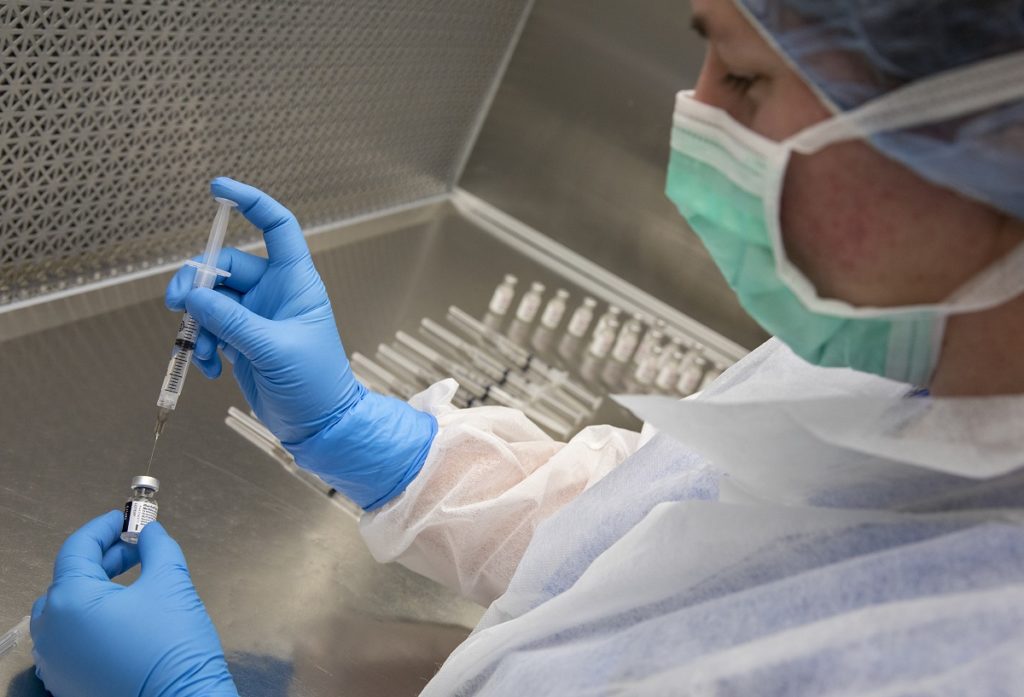
Kayla Valentine, a pharmacy technician at Hershey Medical Center, prepares the vaccine for the staff.
Messick and a team of pharmacy technicians gather around the refrigerator for a standup meeting.
Messick runs down a few of the day’s general announcements – pharmacy has updated its phone tree, there’s a temporary shortage of one type of equipment.
On this day, she tells them, 75 adults have been admitted to the hospital with COVID-19. Four children in the emergency department have the disease.
“So the COVID vaccine showed up today,” she says. Then she explains what’s happened so far and describes what’s to come.
Taking the 16 vials from the refrigerator, Pharmacy Technician Kayla Valentine steps through a glass-windowed door, slips on shoe coverings, a gown and rubber gloves.
She carries the vials to what looks like a large metal desk. According to federal guidelines, diluting the vaccine in this metal hood, which helps ensure a sterile environment, allows it to be injected into a patient up to six hours after Valentine removes it from the refrigerator.
Using small needles provided by Pfizer, Valentine injects 1.8 milliliters of saline into each vial. Then, following instructions from the manufacturer, she holds each tiny jar in her fingers and turns it upside down 10 times. Shaking the vials damages the vaccine.
Inside each container, the COVID-19 vaccine becomes milky.
Hershey Medical Center initially plans to vaccinate as many of its employees as it can, working 14-hour shifts, administering 48 doses per hour. That means pharmacy technicians like Valentine will do this work with an even larger number of vials and saline solution four times a day.
3:39 p.m. Into the arm
Donovan McQuaite, a third-year anesthesia resident, races through the hospital toward the College of Medicine. He’d earlier received an email that his date with the needle is sometime today. At 3:15 p.m., he made a phone call. It’s in 35 minutes, they told him.
“I guess I just walked faster than everybody else,” he said.
Scheduling appointments like McQuaite’s required a large, Penn State Health systemwide effort, says Julie Miller, interim vice president of Penn State Health Medical Group’s Academic Practice Division. How do you allow 20,000 employees to voluntarily schedule vaccinations, then separate them into mandated hierarchies and make sure you’re reporting everything to the Pennsylvania Department of Health, as required by law?
The first systemwide scheduling approach quickly proved unequal to the task. Using continuous and rapid improvement techniques, the team opted for a web-based sign-up tool, SignUpGenius, to allow employees in each tier to select their first dose vaccination date and time.
Dozens of Penn State Health employees have joined the cause – sometimes hunting in wings of the hospital for candidates to keep up with perishable supplies. It’s a busy job, and the 60 or 70 employees performing the task have other full-time schedules they must keep.
“The real story here,” Miller says, “is the teamwork.”
A few months earlier, McQuaite donned a powered air-purifying respirator and met, face-to-face, for the first time with a patient with COVID-19.
“It’s scary,” he said. Since the illness first arrived at Hershey Medical Center’s doorstep in February, he and his wife, Korie, who works at Hershey as a physician assistant, have been careful. They wash their hands religiously, never go out without a mask and seldom venture anywhere, opting to stay at home with their 3-year-old son Kieran and 1-year-old daughter Kennedy.
Despite all the precautions, the reality of the illness is omnipresent for McQuaite, who routinely intubates patients with COVID. “I’m exposed pretty regularly,” he says.
So, when the opportunity arrived to get the vaccine, he jumped. And now he’s here 10 minutes early for his appointment.
“We don’t have any vaccine yet,” someone tells him.
But within minutes, Messick arrives cradling a sandwich bag filled with the 16 purple-capped vials.
In rooms across the hall, health care workers have been assigned to monitor the recipients. After becoming the first person in Hershey Medical Center history to receive the vaccine, McQuaite will wait in the room for 15 minutes while colleagues watch him to see if he has any immediate adverse effects.
McQuaite is first, but already a line is forming. Dr. Muhammad Khalid, chief of the Division of Hospital Medicine, is ready for his shot, even though he’s hated needles since he was a boy. Khalid helped establish the Medical Center’s COVID units and has worked long hours fighting the pandemic. He’s stayed at nearby hotels, avoided his aging parents and spoken to loved ones through glass doors for the better part of a year.
As for whether or not to get the vaccine, “There was never a question,” he says.
Nurse Manager Lori Bechtel prepares McQuaite’s shot. Bechtel manages Employee Health at Hershey Medical Center. When the pandemic began, she created an employee call center.
“It’s just so exciting,” she says of giving the first shot. “It feels like a step in the right direction.”
McQuaite removes his sweater, revealing an Arizona Diamondbacks T-shirt. “I’m nervous,” he says, sitting in the chair next to Bechtel.
“You ready?” Bechtel says.
“Do it,” McQuaite says. He raises a fist in triumph. “Yeah,” he says as the needle goes in.
Applause popcorns throughout the room.
“You did it,” Bechtel says. “Congratulations!”
“It’s quite an honor to live on in the history books,” McQuaite says, texting his wife moments later in the recovery room. “Hopefully, I can live up to that honor.”
If you're having trouble accessing this content, or would like it in another format, please email Penn State Health Marketing & Communications.
